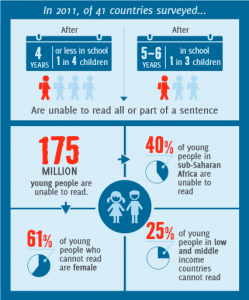Access to education is not the whole story
By AdministratorNext year is 2015, the goal year for the United Nations Millennium Development Goals. Although significant progress has been made toward achieving these goals, many targets have not been reached. For Goal 2: Achieve universal primary education, and other goals relating to education, a rethinking of strategy is needed: It is becoming apparent that simply getting children into school isn’t enough. There’s more to quality education than access alone.
Worldwide, 250 million children cannot read or write, and cannot do basic arithmetic. Of these children, 130 million are currently in school, and this illiteracy and innumeracy can persist even through years of education: One in four children is unable to read all or part of a sentence after four whole years in school. After five to six years, the proportion actually increases, to one in three children. Children are falling further behind in schools instead of gaining more skills.
Many children in school are not learning – so the problem is not only about access, but also about the quality of education being received. One of the major problems worldwide is pupil-to-teacher ratios, which can often rise higher than forty pupils per teacher. These ratios are dropping admirably fast; a bigger problem is the ratio of pupils to trained teachers. In many countries, a quarter of all teachers are not trained according to national standards. In some, it’s as high as half of all teachers. This means that in certain cases where the pupil:teacher ratio looks all right, there are actually as many as 70 pupils for every trained teacher – and sometimes even hundreds of pupils to one trained teacher. A lack of diversity among teachers can further complicate the problem, leaving children without access to a teacher able to communicate in their language or understand other needs.
Another problem is infrastructure. Lack of access to books, classrooms, stationery, and other equipment like science laboratories and computers can be a significant obstacle to learning. Many schools also lack access to basic water and sanitation, with no or very few toilets (often not segregated by sex) and no running water. This is often a problem particularly for girls, who stay away from school in order to avoid using unsegregated toilets, and may develop health problems through avoiding going to the toilet.
Given the transformative power of education to reduce poverty, stimulate economic growth, empower women, and reduce child and maternal mortality, a lack of quality education is clearly as significant a problem as lack of access to education. At the 69th session of the UN General Assembly in September this year, the Global Education First Initiative (GEFI), which was launched to accelerate progress toward global Education For All goals, held an event focusing on the importance of international partnerships in making universal quality education a reality. The Education for All (EFA) goals for 2030, which take into account analyses of the obstacles in achieving the 2015 Millennium Development Goals, now incorporate the importance of assessment to determine progress toward targets. Ongoing goals include the monitoring of whether children are in fact acquiring foundational educational skills, as well as the strengthening of national assessment systems that can identify groups that are not learning, and understand which groups are not taking part in assessment.
One of the most vital factors in achieving these goals is ongoing investment in education. In order to improve ratios of pupils to trained teachers, and replace teachers who will retire and leave the profession, 20.6 million teachers will need to be recruited over the next 15 years. In order to attract skilled individuals to the profession, keep them in the profession, support them, and send them to areas where they are most needed – such as poverty-stricken and rural areas – competitive pay packages will be needed. Additionally, female teaching professionals must be given the societal and political recognition to be able to do their jobs effectively. The improvement of infrastructure and collection of data will also require financing. The finance gap to achieve the 2030 goals is currently sitting at US$38 billion. As international aid decreases, this gap will only increase. At this stage, investment in education is critical, and likely to pay huge dividends in improving the health and welfare of the communities served.
Foundation Beyond Belief, in its ongoing support for the Millennium Development Goals, will be incorporating these specific targets – including training and support of teachers, provision of infrastructure such as learning materials and sanitation, and monitoring and assessment – into its charity selection processes.
Posts in this series:
FBB aligns with UN effort to end poverty
Millennium Development Goal 1: Eradicate extreme poverty and hunger
Millennium Development Goal 2: Achieve universal primary education
Millennium Development Goal 3: Promote gender equality and empower women
FBB’s Millennium Development Goals track record
Millennium Development Goal 4: Reduce child mortality
Millennium Development Goal 5: Improve maternal health
Millennium Development Goal 6: Combat AIDS/HIV, malaria, and other diseases
Millennium Development Goal 7: Ensure environmental sustainability
Millennium Development Goal 8: Develop a global partnership for ongoing development
References: EFA Global Monitoring Report 2013/4
The entire infographic that the thumbnail above is taken from can be viewed in its entirety here.

